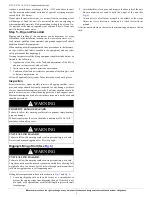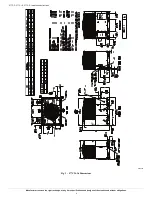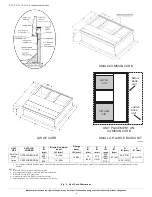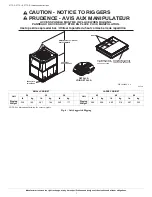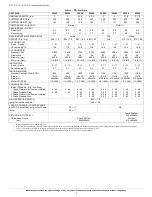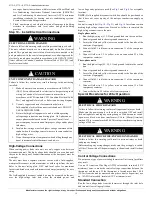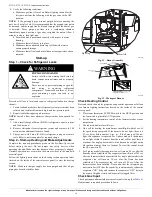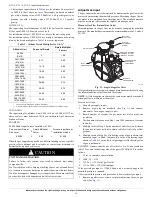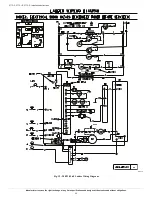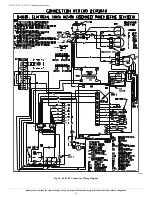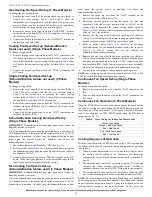
577C--C, 577C--E, 577C--F: Installation Instructions
Manufacturer reserves the right to change, at any time, specifications and designs without notice and without obligations.
13
Locate six (seven for 3-phase) 18-gage wires leaving control box. These
low-voltage connection leads can be identified by the colors red, green,
yellow, brown, blue, and white (See
). A gray wire is standard on
3-phase units for connection to an economizer. Ensure the leads are long
enough to be routed into the low-voltage splice box (located below right
side of control box). Route leads through hole in bottom of control box
and make low-voltage connections (See
). Secure all cut wires, so
that they do not interfere with operation of unit.
A09053
Fig. 10 – High- and Control-Voltage Connections
Heat Anticipator Setting (Electro-Mechanical
Thermostats only)
The room thermostat heat anticipator must be properly adjusted to
ensure proper heating performance. Set the heat anticipator, using an
ammeter between the W and R terminals to determine the exact required
setting.
NOTE:
For thermostat selection purposes, use 0.18 amp for the
approximate required setting. Failure to make a proper heat anticipator
adjustment will result in improper operation, discomfort to the occupants
of the conditioned space, and inefficient energy utilization; however, the
required setting may be changed slightly to provide a greater degree of
comfort for a particular installation.
Transformer Protection
The transformer is of the energy-limiting type, however a direct short
will likely blow a secondary fuse. If an overload or short is present,
correct overload condition and check for blown fuse on Indoor Fan
board or Integrated Gas Controller. Replace fuse as required with correct
size and rating.
Pre-Start-up
Use the Start-Up Checklist supplied at the end of this book and proceed
as follows to inspect and prepare the unit for initial start-up:
).
2. Read and follow instructions on all DANGER, WARNING,
CAUTION, and INFORMATION labels attached to, or shipped
with unit.
3. Make the following inspections:
a. Inspect for shipping and handling damage, such as broken lines,
loose parts, disconnected wires, etc.
b. Inspect all field- and factory-wiring connections. Be sure that
connections are completed and tight.
c. Ensure wires do not touch refrigerant tubing or sharp sheet metal
edges.
d. Inspect coil fins. If damaged during shipping and handling,
carefully straighten fins with a fin comb.
POWER
SUPPLY
FIELD-SUPPLIED
FUSED DISCONNECT
HIGH VOLTAGE
POWER LEADS
(SEE UNIT WIRING
LABEL)
EQUIP GR
3-PHASE SHOWN
1-PHASE USES
TWO POWER
LEADS
CONTROL BOX
SPLICE BOX
LOW-VOLTAGE
POWER LEADS
(SEE UNIT
WIRING LABEL)
W
Y
G
R
C
WHT(W)
YEL(Y)
GRN(G)
RED(R)
BRN(C)
THERMOSTAT
(TYPICAL)
DH
BLU(DH)
GRA(Y2)
3-Phase
Only
WARNING
!
ENVIRONMENTAL, FIRE, EXPLOSION, ELECTRICAL
SHOCK HAZARD
Failure to follow this warning could result in personal injury or death.
1. Follow recognized safety practices and wear protective goggles
when checking or servicing refrigerant system.
2. Do not operate compressor or provide any electric power to unit
unless compressor plug is in place and secured.
3. Do not remove compressor plug until all electrical sources are
disconnected and tagged.
4. Relieve and recover all refrigerant from system before touching
or disturbing compressor plug if refrigerant leak is suspected
around compressor terminals.
5. Never attempt to repair soldered connection while refrigerant
system is under pressure.
6. Do not use torch to remove any component. System contains oil
and refrigerant under pressure.
To remove a component, wear protective goggles and proceed
as follows:
-Shut off electrical power to unit and install lockout tag.
-Relieve and reclaim all refrigerant from system using both
high- and low-pressure ports.
-Cut component connecting tubing with tubing cutter and
remove component from unit.
-Carefully unsweat remaining tubing stubs when necessary. Oil
can ignite when exposed to torch flame.
WARNING
!
FIRE, EXPLOSION HAZARD
Failure to follow this warning could result in personal injury, death or
property damage.
Do not purge gas supply into the combustion chamber. Do not use a
match or other open flame to check for gas leaks.
Use a commercially available soap solution made specifically for the
detection of leaks to check all connections. A fire or explosion may
result causing property damage, personal injury or loss of life.



